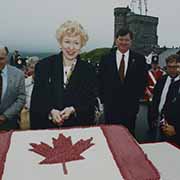CANADA HISTORY
Kim Campbell

Kim Campbell's rise and fall in Canadian federal politics marks one of the most dramatic chapters in the country's political history. As Canada's first female Prime Minister, Campbell's tenure was both historic and short-lived, reflecting the volatile nature of politics and the challenges of leading a party in decline. Her ascent to the highest office in the land was a significant milestone, symbolizing the breaking of gender barriers in Canadian politics, but her subsequent defeat in the 1993 general election also highlighted the difficulties of inheriting a troubled party and navigating a hostile political landscape.
Early Life and Education
Kim Campbell, born Avril Phaedra Douglas Campbell on March 10, 1947, in Port Alberni, British Columbia, grew up in Vancouver. Her early life was marked by personal challenges, including her parents' separation, which led her to change her name from Avril to Kim at the age of 12. Campbell showed an early interest in leadership and politics, becoming the first female class president at Prince of Wales Secondary School. Her education journey took her to the University of British Columbia (UBC), where she earned a Bachelor's degree in Political Science in 1969, followed by postgraduate studies at the London School of Economics in Soviet Studies. Although she did not complete her PhD, this academic background laid the foundation for her future in politics.
Entry into Politics
Campbell's first foray into politics came at the local level when she was elected to the Vancouver School Board in 1980. Her time on the board was a significant stepping stone, helping her hone her political instincts and gain public visibility. She then transitioned to provincial politics, running as a candidate for the Social Credit Party in the 1984 British Columbia election. Although unsuccessful in her first attempt, she served as a policy advisor to Premier Bill Bennett, further solidifying her presence in provincial politics. Campbell ran again in 1986 and won a seat in the provincial legislature, where she was noted for her progressive stance on women's reproductive rights, supporting greater access to abortion—a position that often put her at odds with the more conservative factions of her party.
Rise in Federal Politics
In 1988, Campbell shifted to the national stage, winning the Vancouver Centre seat as a member of the Progressive Conservative Party under Prime Minister Brian Mulroney. She quickly made a name for herself in Ottawa, and by 1989, she had joined the federal cabinet as Minister of State for Indian Affairs and Northern Development. In 1990, Campbell was promoted to the highly influential post of Minister of Justice and Attorney General of Canada, making her the first woman to hold the position. During her tenure, Campbell took on significant issues, such as tightening gun control laws and reforming sexual assault legislation, ensuring the rights of victims were prioritized.
Her effectiveness as Minister of Justice earned her further recognition, and in 1993, she was appointed Minister of National Defence, the first woman to hold that post as well. However, her time in this role was marked by controversy, particularly surrounding the Somalia Affair, where Canadian peacekeepers were involved in the torture and murder of Somali civilians. Despite these challenges, Campbell’s public profile continued to rise, and she was seen as a potential future leader.
Becoming Canada's First Female Prime Minister
By 1993, the Progressive Conservative Party under Brian Mulroney was deeply unpopular due to the lingering effects of the Goods and Services Tax (GST) and the failure of the Meech Lake Accord. Mulroney, recognizing the political climate, decided to step down as Prime Minister. Campbell, with her growing popularity and charisma, emerged as a fresh face who could revitalize the party. In June 1993, she won the Progressive Conservative leadership, defeating Jean Charest, and became Canada's 19th Prime Minister—the first woman to hold the office.
Campbell's ascent to the highest political office in Canada was seen as a groundbreaking moment for women in politics. Her early days as Prime Minister were marked by popular moves, such as reducing the size of the federal cabinet from 35 to 23 ministers and promoting an image of change and renewal. She was also the face of Canada at the G7 Summit in Tokyo, and her approval ratings soared, reaching over 50% during the summer of 1993.
The 1993 Election and Downfall
Despite her initial popularity, the optimism surrounding Campbell's leadership quickly began to fade as the 1993 general election approached. In a political environment still reeling from Mulroney’s deeply unpopular policies, particularly the GST and the free trade agreement with the United States, Campbell faced the challenge of distancing herself from Mulroney while maintaining the party’s core base. Although she attempted to reframe the Progressive Conservatives as a renewed party, the public’s association of her with the Mulroney administration remained strong.
One of the turning points in the election campaign was the Conservative Party’s use of negative attack ads targeting Liberal leader Jean Chrétien. These ads, which seemed to mock Chrétien’s facial paralysis—a result of Bell’s palsy—backfired spectacularly, leading to a public outcry against Campbell and the Progressive Conservatives. The ads were widely condemned as mean-spirited, and although Campbell disavowed them, the damage was done. Chrétien capitalized on the Conservatives’ misstep, presenting himself as a compassionate alternative to Campbell's government.
As the campaign progressed, the Progressive Conservatives' support continued to erode, not only due to the attack ads but also because of Campbell's own missteps, including a comment suggesting that discussing the economy during the campaign was too complex for voters. The party's strategy was disjointed, and they struggled to effectively communicate their platform, particularly in the face of surging support for Jean Chrétien’s Liberals and the Reform Party in the West.
The Election Results and Legacy
The 1993 election was one of the most devastating defeats in Canadian political history. The Progressive Conservatives were nearly obliterated, going from 156 seats in the House of Commons to just two. Kim Campbell lost her own seat in Vancouver Centre, and the party’s base was decimated, with many traditional Conservative voters defecting to the Reform Party in Western Canada or the Bloc Québécois in Quebec.
Campbell's time as Prime Minister lasted only four months, making her tenure one of the shortest in Canadian history. The scale of the defeat was so catastrophic that it left the Progressive Conservative Party in ruins, leading to its eventual merger with the Canadian Alliance in 2003, which resulted in the creation of the modern Conservative Party of Canada.
While Campbell's political career ended abruptly, her legacy as Canada’s first female Prime Minister remains significant. She broke a major barrier for women in Canadian politics, and her time in office, though brief, demonstrated that women could ascend to the highest levels of political leadership. However, her rise and fall also serve as a cautionary tale about the challenges of inheriting a troubled party and the difficulties of navigating political crises and public perception.
Kim Campbell’s political journey is a unique chapter in Canadian history. Her swift rise to become Canada’s first female Prime Minister was a groundbreaking achievement, but her equally rapid fall reflected the deep-seated challenges facing the Progressive Conservative Party in the early 1990s. Despite the brevity of her time in office, Campbell's role as a trailblazer for women in Canadian politics and her contributions in various cabinet positions, including Justice Minister and Defence Minister, cement her place in the country’s political history. Her career highlights the complexities of leadership, the volatility of electoral politics, and the enduring impact of gender barriers in public life. Although her time in office was short, Kim Campbell remains an important figure in the story of Canadian political evolution.
Cite Article : www.canadahistory.com/sections/documents




